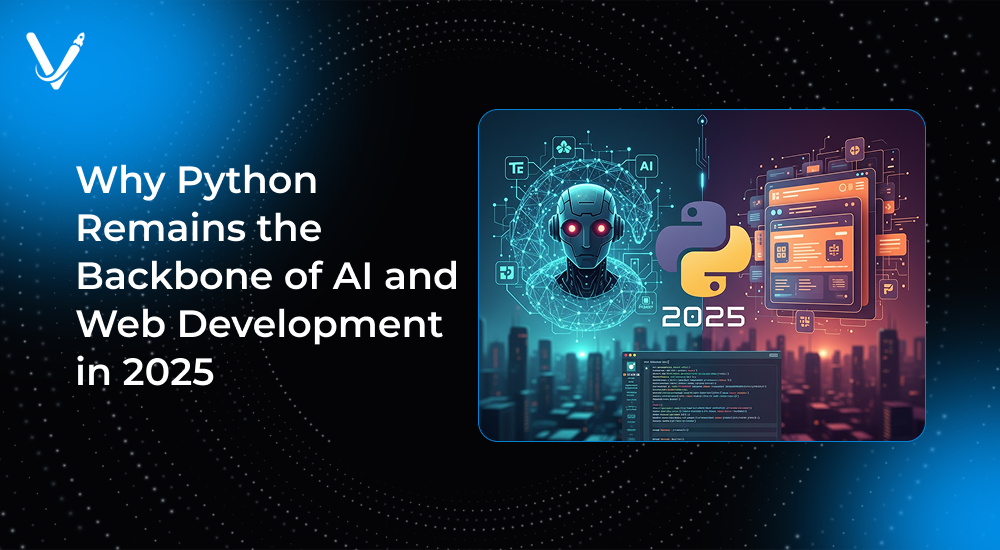Why Python Remains the Backbone of AI and Web Development in 2025


- Nov 8, 2025



Key Takeaways
In 2025, the technology landscape is evolving at lightning speed. Artificial Intelligence (AI) systems are automating complex decisions, and web platforms are becoming increasingly intelligent and interactive. Yet amid this constant evolution, one programming language has stood firm as the foundation of innovation — Python.
Python has been the silent powerhouse behind groundbreaking AI tools, dynamic web applications, and enterprise-level solutions. It isn’t just a coding language anymore — it’s the connective tissue that binds machine intelligence with digital user experiences.
In this blog, we’ll explore why Python remains the backbone of AI and web development in 2025, diving deep into its ecosystem, community, versatility, and the reasons it continues to outshine other languages. Whether you’re building predictive models, designing APIs, or deploying scalable applications, Python continues to lead the way.
Python’s journey began in the early 1990s, but it wasn’t until the rise of AI and web frameworks that it became the cornerstone of modern development. Its growth is not accidental — it’s the result of deliberate design decisions prioritizing readability, simplicity, and adaptability.
The year 2025 marks a new chapter for Python. With advancements like Python 3.12, improved async capabilities, type hinting, and tighter cloud integrations, the language continues to evolve in sync with global digital transformation trends.
Companies ranging from startups to global enterprises depend on Python because it offers:
Python isn’t just surviving the changing tides of technology — it’s shaping them.
Artificial Intelligence is no longer a buzzword — it’s an essential driver of business transformation. From predictive analytics and natural language processing to self-learning algorithms and autonomous systems, AI technologies rely heavily on Python’s ecosystem.
Here’s why Python continues to be the de facto standard for AI development in 2025.
Python’s biggest strength in AI lies in its comprehensive collection of libraries that simplify complex computational tasks. Frameworks like:
These libraries empower developers to build and scale intelligent models without reinventing the wheel. Python’s vast library network has grown exponentially, making it easy to integrate AI into any domain — healthcare, finance, retail, or entertainment.
AI workflows today demand smooth integration across multiple platforms and services. Python fits perfectly because it acts as the glue between technologies. Whether you’re connecting APIs, managing cloud resources, or integrating with GPU-based computation frameworks, Python’s interoperability makes it ideal for complex machine learning pipelines.
Machine learning models require collaboration among data scientists, analysts, and engineers — many of whom come from non-CS backgrounds. Python’s syntax resembles plain English, reducing the learning curve and enabling interdisciplinary teams to work together efficiently.
This simplicity fuels creativity and experimentation — essential qualities in AI innovation.
Python’s AI community is one of the largest in the world. Every day, developers contribute new modules, optimize algorithms, and publish research-ready code. This constant evolution ensures that the latest advances in AI — from generative models to edge inference — are quickly accessible through Python.
Leading tech giants like Google, OpenAI, Microsoft, Meta, and Amazon continue to rely heavily on Python for developing and deploying AI-driven products. Its role in powering ChatGPT, Autonomous Vehicles, Recommendation Systems, and AI Assistants underscores its centrality to innovation in 2025.
Beyond AI, Python is revolutionizing how businesses build and scale their online presence. In 2025, web applications are no longer static pages; they are dynamic, data-driven ecosystems — and Python powers many of them.
Python’s frameworks like Django and Flask continue to set the gold standard in web development.
Both frameworks now integrate effortlessly with AI APIs, cloud services, and microservices architectures, enabling developers to build intelligent, responsive web systems.
The emergence of FastAPI has transformed how Python handles API development. Built for high-performance and async operations, FastAPI supports automatic validation, OpenAPI documentation, and blazing-fast request handling — making it perfect for AI-based applications where speed matters.
Python doesn’t compete with front-end stacks like React, Angular, or Vue; it complements them. Using APIs built on Django Rest Framework or FastAPI, Python serves as the robust backend that powers interactive, user-friendly frontends.
This combination ensures that businesses can leverage the best of both worlds — Python’s backend strength and modern front-end interactivity.
Security remains a top concern for web developers in 2025. Python frameworks are built with security at their core, offering built-in protections against threats like SQL injection, cross-site scripting, and data tampering. Django’s middleware architecture and role-based access controls continue to make it the preferred choice for enterprise-grade web platforms.
The biggest advantage of using Python for web development is the seamless integration of AI models into web applications. Companies can easily integrate chatbots, predictive recommendation systems, and image recognition features into existing apps using Python libraries.
This convergence of AI + Web Development is redefining the user experience — making websites more personalized, predictive, and interactive.
Data is the new currency of the digital era. In 2025, organizations rely on data to predict consumer behavior, streamline operations, and drive growth. Python serves as the primary tool for data professionals worldwide due to its extensive analytical capabilities.
With libraries like Pandas, NumPy, Matplotlib, and SciPy, Python enables:
Tools such as Jupyter Notebook make experimentation and visualization intuitive, while integration with cloud platforms like AWS and Google Cloud ensures scalability.
In essence, Python has democratized data science — making it accessible to anyone with curiosity and a dataset.
Automation has become essential in managing cloud infrastructures, CI/CD pipelines, and application deployment. Python’s scripting capabilities make it a top choice for DevOps engineers and system administrators.
In 2025, tools like Ansible, SaltStack, and Fabric still rely on Python for orchestrating complex systems. Developers use it to automate everything from testing to deployment, ensuring seamless workflows in multi-cloud environments.
Its lightweight syntax and cross-platform capabilities make Python scripts easy to maintain, integrate, and execute — saving businesses valuable time and resources.
Companies around the world continue to favor Python due to its cost-effectiveness, scalability, and long-term sustainability. Let’s explore why enterprises consider it the strategic backbone of their digital initiatives.
Python’s simplicity allows teams to develop, test, and deploy applications quickly. Startups and enterprises alike benefit from faster iteration cycles, ensuring they stay competitive in a fast-moving market.
Because Python is easy to learn and widely taught in universities, there’s an abundant talent pool of developers, data scientists, and engineers proficient in it. This reduces hiring friction and ensures businesses always find qualified experts to scale their projects.
Python is not limited to a single industry. It powers:
This cross-domain versatility ensures Python remains the unifying language of innovation.
The Python community is constantly refining libraries, frameworks, and standards. As a result, businesses benefit from open-source contributions that reduce development costs and keep their systems at the cutting edge.
In 2025, cloud-native development and edge computing are two pivotal areas of innovation. Python remains central to both.
Cloud service providers like AWS, Azure, and Google Cloud offer Python SDKs to manage resources, deploy models, and monitor usage. Meanwhile, edge AI frameworks such as TensorFlow Lite and ONNX Runtime make Python the go-to language for building models that run efficiently on IoT and embedded devices.
This cross-environment adaptability — from the cloud to the edge — ensures that Python solutions scale seamlessly across diverse infrastructures.
Critics often point to Python’s slower runtime compared to C++ or Rust. But 2025 has brought several advancements that bridge this gap:
These enhancements ensure that Python retains its flexibility while achieving performance levels suitable for even the most demanding workloads.
Behind every successful technology is a passionate community. Developers love Python for its expressive syntax, readability, and collaborative culture.
They can experiment, iterate, and scale ideas quickly without getting bogged down in syntax-heavy code. Python’s adaptability allows them to move seamlessly between data analysis, backend development, and automation — all within a single ecosystem.
The 2025 developer culture revolves around productivity and creativity, both of which Python enables effortlessly.
Frameworks like Django AI and FastAPI AI Extensions now include built-in modules to integrate machine learning models directly into web endpoints — reducing deployment complexity.
Python interfaces like Qiskit and Cirq are empowering developers to explore the quantum era. Python acts as the bridge between traditional computing and the quantum future.
Python dominates the serverless architecture movement with AWS Lambda and Google Cloud Functions, enabling cost-efficient and scalable microservices powered by AI backends.
The Python community has also embraced eco-friendly development. Optimized libraries and efficient frameworks help minimize energy consumption — aligning Python with the future of sustainable tech.
While languages like JavaScript, Go, and Rust have gained traction, Python continues to reign supreme because of its versatility and maturity.
| Feature | Python | JavaScript | Go | Rust |
| Ease of Learning | Excellent | Moderate | Moderate | Complex |
| AI/ML Support | Exceptional | Limited | Moderate | Low |
| Web Development | Django, Flask, FastAPI | Node.js | Fiber, Gin | Rocket |
| Community Support | Massive | Large | Growing | Niche |
| Use Cases | AI, Web, Automation, Data | Web, UI | Systems, APIs | Performance, Security |
Python’s ecosystem and developer support remain unmatched, making it the most pragmatic choice for long-term projects.
These success stories highlight Python’s adaptability to every use case imag+inable.
The next decade will continue to be shaped by AI, automation, and data intelligence — all areas where Python excels. With enhancements in parallel computing, GPU integration, and cross-platform deployment, Python is evolving into a smarter, faster, and more connected ecosystem.
Its open-source nature ensures that developers will continue to refine it for emerging technologies like Generative AI, Quantum Computing, Blockchain, and Extended Reality (XR).
In short, Python isn’t just surviving the future — it’s defining it.
As 2025 unfolds, Python remains the backbone of innovation in both AI and web development. Its simplicity empowers creativity, its libraries accelerate innovation, and its community fuels progress. Businesses across the globe trust Python because it delivers — reliable, scalable, and intelligent solutions that stand the test of time.
If you’re building AI models, scaling web platforms, or designing data-driven systems, Python offers everything you need to lead in the digital era.
Ready to build future-ready AI and web solutions with Python?
Partner with Vasundhara Infotech — where innovation meets intelligent development. Our Python experts craft scalable, high-performance systems that elevate your business to the next level.
Copyright © 2025 Vasundhara Infotech. All Rights Reserved.